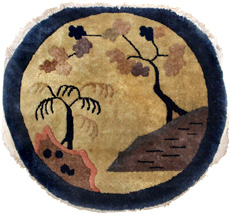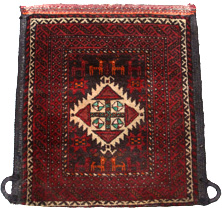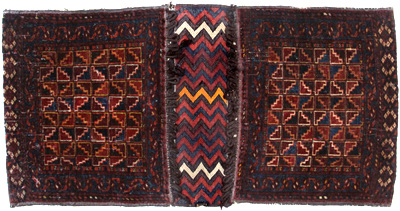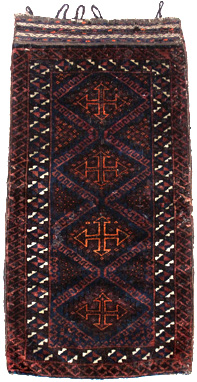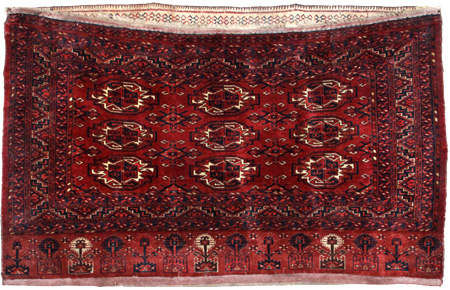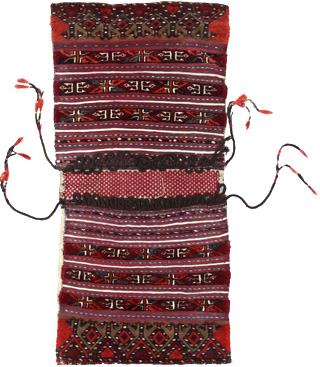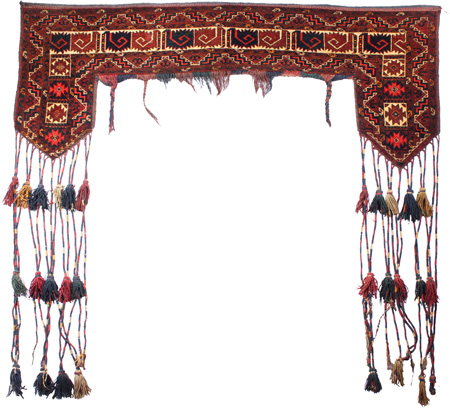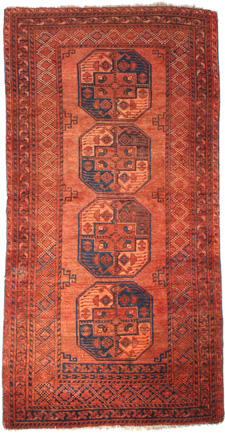Antique Oriental Carpets & Rugs
This Persian carpet shop gave me the feeling of a legendary oriental palace.
Coming closer to the window and staring inside,
had a strange effect: no glorious king or beautiful princess were detected - the
only live item in view was the dark whiskered face of the shop's owner. Usually,
he was sitting behind a big desk, doing nothing. He reminded me of one of the merchant
characters in the film "The
Thief of Bagdad", and arose a vague, unexplained fear.
But the charm was not dispelled. From this closer point of view, I was exposed to
the striking beauty of Persian carpets, Caucasian and Bukhara rugs and big Turkmen
bags. I studied the intricate weaving patterns, felt, although I could not touch,
the thickness and softness of the wool, and hallucinated the fantastic colors of
the knotted piles. I wondered - will I ever be able to understand the meaning of
the strange murmurings which came out when the shop owner was talking with his heavy
eyebrows guests:
Afghan, Turkmen,
Beluch, Chuval, Bolesht, Torbah,
Khourjin, Jallar Paidar?
And then, one sunny day, when I dragged myself, as usual, back from school, I suddenly
found out that some of the most beautiful oriental rugs which I used to watch through
the window, were now lying in front of the shop, tiling the pavement with their
glimmering ornaments. I was startled by the idea that in a few seconds, if I continue
my course, I will have to step on the stuff that legends are made of. I froze. There
was no bypass.
But then, another surprise had occurred. The mustached owner who was standing at
the door, encouraged me, first by using hand gestures, and then, verbally, to step
on his carpets! I didn't dare arguing with him. I just followed, speechless, his
instructions.
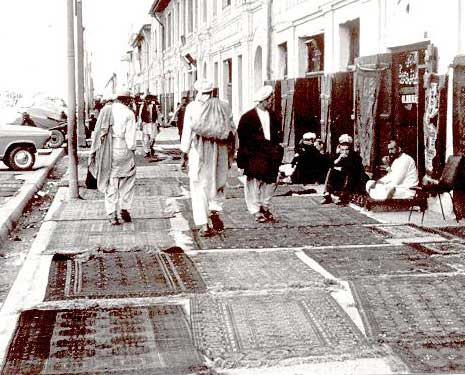
A long time has passed since then. I traveled around a bit, and now I know that
laying carpets in the sun is a common practice of carpet dealers especially in oriental
countries.
I know there is a good reason for it - periodic exposure to sunlight and vibrations (when face of the rug is upside down) are great countermeasures against moth and other enemies of rugs. But I also know that stepping on a beautiful carpet may change your life forever - be my guest.
List of Antique Oriental Rugs and Carpets
Antique Chinese Peking Rug - Rounded Seat Cover
This beautiful antique Chinese rug is distinctive by its classic theme motif as well as by its unusual contrasting yet soft colors. It was planned to be used as a seat cover and has a circular field with a picture of a traditional Chinese nature landscape of two trees snuggling with each other by their branches and flowers. Unlike most of the oriental rugs, Chinese designs are very literal and descriptive rather than decorative and transmits the deep energy of harmony and beauty. Be seated.
שטיח סיני מסורתי עתיק ואיכותי כובש אותך בתחושה הפנימית של הרמוניה, איזון ויופי הנובעים מן הפשטות המושלמת של תרבות בת אלפי שנים. דוגמאות המבוססות על סצנות מן הטבע, בעלות משמעויות סימבוליות קונפוציאניות ותאואיסטיות שאינני מבין, מועתקות מדור לדור בידי טוות שטיחים מיומנות - אותי זה מרגיע.
Size: 1' 10.4" x 2' 0.4" - 57 cm x 62 cm - 22.4
in x 24.4 in
Warp: Cotton
Face thickness: 10 mm approx
Pile: Wool
Origin: China, Peking
Weaving technique: Knotted and piled hand weaving
Age: more than 100 years old (late 19th or early 20th century).
Our ref #: R1007/22 - More Details about the Antique Peking Rug
Antique Baluch Khorjin - a Donkey Saddle Bag
This is a beautiful half of a knotted and piled Khorjin (aka as Khourjeen or Khorjun - read more about the many alternate spellings of this Farsi word). It is often called a "Donkey Bag" or a "Saddle bag", though it was usually used as a pannier bag which was carried by a man over the shoulder. These bags are type of tribal rugs which were made in joined pairs throughout Iran, Afghanistan, Turkmenistan and Baluchistan. When pairs are separated, the halves are normally used as small mats, bags or cushion covers.
שק המטען, החורג'ין Khorjin שימש את הנוודים בטורקמניסטן ובאפגניסטאן בחיי היום יום. אם אין חמור משתמשים בשק אחד (חצי חורג'ין) ממלאים ונושאים על הכתף. אם יש חמור תולים זוג שקים משני צידי החמור, ממלאים והחמור סוחב.
Size: 1' 8.9" x 1' 7.7" - 54
cm x 50 cm - 21.3 in x 19.7 in
Warp: Wool
Face thickness: 6 mm approx
Pile: Wool & Silk
Origin: Tribal groups of Afghanistan and Iran - Beluch from Mashad
/ Ferdows
Weaving technique: Knotted and piled - hand weaving
Age: more than 100 years old (late 19th or early 20th century).
Our ref #: R1002/14 - More Details about the Antique Baluch Pannier Bag
Antique Baluch Khorjin - a Complete Pair of big Saddle Bags
The Baluch pile weaving groups that inhabited the tough areas of northeastern Iran and western Afghanistan, excelled in weaving fascinating dark and mysterious rugs for their daily nomadic way of life. See how the talented weaver of this complete pair of Khorjin saddle bags succeeded in generating an intelligent and sophisticated grid structure which occupies the fields of the Khorjin's bag faces by using of varying colors, deep blue highlights and an uncommon effect of diagonal staircase which cuts each of the squares in the grid - amazing.
"לאחר שאלוהים ברא את העולם, הוא יצר את בלושיסטאן מן האשפה שנותרה" זוהי אמרה נפוצה בחבל הארץ שבו נוצרו כמה מסוגי השטיחים היותר מעניינים ויוצאי הדופן בעולם המזרח. ערבה מוקפת הרים, צחיחה ומבודדת - מפתיע כיצד בתנאים קשים אלו התפתחה תרבות אריגת שטיחים משובחים בעלת ערכים אסתטיים מיוחדים במינם כפי שרואים במשטחי הפנים של זוג שקי האוכף Khorjin שלפנינו.
גם כיום חבל בלוציסטאן הוא איזור מלחמה שכוח אל, מוכה צרות, הנחלק לכאורה בין איראן, פקיסטאן ואפגניסטאן - ולמעשה נמצא בשליטת הטאליבן.
Size: 3' 10.1" x 1' 10.8" - 117 cm x 58 cm -
46.1 in x 22.8 in
Warp: Wool
Face thickness: 8 mm approx
Pile: Sheep & Camel wool
Origin: Tribal groups of Afghan and Iran - Baluch
Weaving technique: Combined knotted and piled and Kilim flat hand weaving
Age: more than 100 years old (late 19th century).
Our ref #: R1006/11 - More Details about the Completer Pair of Baluch Saddle Bags
Antique Baluch Bolesht (Balisht) - a Baluch Pillow Bag
The Bolesht (also pronounced Balesht, Balisht, Bolisht, Bolish and Balish) is the Farsi word for a pillow. The Bolesht bags were used as cushions in the nomads Baluchs' tents as well as in their permanent dwellings. This beautiful complete dark colored Baluch Bolesht measures 98cm x 50cm and has a soft knotted and piled face and a wonderful unique flat woven back which is decorated with bands of colors and overlaid with decorative Kilim panels of "black and white" geometrical patterns. The opening of the bag is at the top and the horse hair loops around the mouth of the bag were used for fastening the stuff inside the Bolesht.
"אם כבר לישון אז על בלישט Balisht בלוצ'י" - כך היה אומר הסבא שלי - אדם פעיל ואספן כפייתי של שטיחים עתיקים מן המזרח. ובאמת, היופי, הרכות ותחושת המסתורין של שקי השינה של הנוודים משבט הבלוץ' Baluch מטיסים את החלומות על מרבד הקסמים.
Size: 3' 2.6" x 1' 7.7" -
98
cm x 50 cm - 38.6 in in x 19.7 in
Warp: Wool
Face thickness: 8 mm approx
Pile: Wool
Origin: Tribal groups of Afghanistan and Iran - Baluch
Weaving technique: Knotted and piled and Kilim flat hand weaving
Age: more than 100 years old (late 19th or early 20th century).
Our ref #: R1004/20 - More Details about the Antique Baluch Pillow Bag
Antique Turkmen Tent Bag - a Yomud Chuval
An intact complete and rare antique Turkmen large tent bag - three by three Juval gull - a Yomud Chuval (aka Juval, Juwal or Choval) with a very unusual and beautiful main border and skirt design. This type of flat storage bag was used in old times for keeping the entire suite of dowry weavings of young Turkmen girls in Afghanistan before their marriage. The richness of the knotting and the amazing pattern of geometrical trees in the skirt part of the bag, are signs of special artistic and professional attention which were typical for weaving of bags that were used in the context of the traditional Turkoman weddings festive occasions.
שקי החתונה Chuval של שבטי הנוודים הטורקמנים היו באמת סיבה למסיבה במרחבים שבין טורקמנסיטאן, פרס ואפגניסטאן של היום. האריגה החלה עוד לפני שהיה חתן. קצב האריגה נקבע על ידי אבי הכלה לפי התנהלות המשא ומתן - אם החתן היה רצוי היו מאיצים, אם לא, היו אומרים שיש עוד הרבה מה לעשות וששקי החתונה אינם מוכנים. בשקים שמו את פריטי הנדוניה: כלי בית, שטיחונים שימושיים, כרים, מפות, בגדים - כל כלה לפי יכולותיה וטעמה. ביום הכלולות היתה הכלה מובלת על גמל / סוס / חמור, שנשא גם את השקים, אל ה"אולם". לאחר החתונה היו השקים נתלים באוהל Yurt של הזוג הצעיר ומשמשים כארונות קיר יפיפיים.
Size: 5' 2.2" x 3' 3.4" - 158 cm x
100 cm - 62.2 in x 39.4 in
Warp: Wool
Face thickness: 6 mm approx
Pile: Wool
Origin: Tribal groups in Turkmenistan / Afghanistan - Yomud
Weaving technique: Knotted and piled hand weaving
Age: more than 100 years old (circa 1890).
Our ref #: R1003/16 - More Details about the Antique Turkmen Tent Bag
Antique Turkmen Saryk Khorjin - an Intact Pair of Saddle Bags
This beautiful complete and intact Saryk Khorjin has an assortment of patterns, materials and weaving techniques with which it was constructed and which give it an exceptional vivid stripes design and fashionable look with great expression of harmony and passion. I wonder whether the lady artist who planed and wove this beautiful pair of saddle bags, had ever wanted them to be laid on a donkey's back and be filled with vegetables and grocery stuff.
החורג'ין הטורקמני הזה הוא יפיפה, ובדמיוני, בת שבט הסאריק Saryk שארגה אותו היתה יפיפיה לא פחות, וזה מה שיפה באריגת השטיחים של שבטי הנוודים באיזורים הנדחים והקשים לחיים שבין אפגניסטאן, איראן ופקיסטאן - אריגת השטיחים הייתה הכרחית כאמצעי עיקרי ליצירת הכלים והאביזרים הדרושים לקיום היום יומי ובה בעת היא הייתה ביטוי מושלם ליצירתיות וליופי שבלבבות.
Size: 3' 3.4" x 1' 7.3" - 100 cm x 49 cm - 39.4
in x 19.3 in
Warp: Wool
Face thickness: 6 mm approx
Pile: Wool, Cotton & Silk
Origin: Tribal groups of Afghan and Iran - Saryk
Weaving technique: Combined knotted and piled and flat hand weaving
Age: more than 100 years old (late 19th or early 20th century).
Our ref #: R1005/19 - More Details about the Antique Saryk Khorjin
Antique Ersari Kapunuk - a genuine Jallar Paidar
Although most of the Turkomans in Afghanistan and Turkestan are now sedentary people, they were originally nomads, herding their flocks of sheep and goats across the rolling steps of Central Asia. They lived in yurts, those circular domed tents seen from Outer Mongolia to the Caspian Sea. These wood framed tents, easily dismantled and reassembled, were lined and roofed with felt and skirted with reed matting, the whole being bound with woven tent bands.
The inside closure of the yurt was a carpet of special design called Purdah (curtain) which was surrounded from its internal side by the gem product of the Turkoman weaving art - the Kapunuk AKA Gapylyk or Jallar Paidar. Read more…
הקפונוק Kapunuk הנהדר שלפנינו הוא פריט אספנות נחשק ויקר ערך שעיטר את הפתח הפנימי של היורט yurt - אוהל הנוודים התורקמני, ושימש מקור גאווה לבעל האוהל, למשפחתו ולאורחיו.
Width of Lintel: 3' 9.3" - 115 cm - 45.3 in
Length of Foot (without tassels): 1' 7.7" - 50 cm - 19.7 in
Width of Foot: 9.8" - 25 cm - 9.8 in
Warp: Wool
Face thickness: 8 mm approx
Pile: Wool
Origin: Tribal groups of Northern Afghanistan - Ersari
Weaving technique: Knotted and piled hand weaving
Age: more than 100 years old (late 19th or early 20th century).
Our ref #: R1009/15 - More Details about the Antique Ersari Kapunuk
Antique Afghan Carpet - the Ersari of Northern Afghanistan
The field of this antique Afghan carpet is composed of four perfectly designed Taghan guls which were woven in a striking color combination of fox-red, pink-salmon and deep green-blue natural dyes. The border of the carpet encloses three rich coloring pink brown stripes which frame the field in a most powerful way: a beautiful "running dog"; a wave of Boteh creatures and a main stripe of vibrant diamonded zig-zag line which forms a continuous wide row of rhombuses that surround the field. This carpet is a rare beautiful masterpiece of Afghan tribal weaving.
השטיחים של שבטי הנוודים באפגניסטן Tribal Afghan Rugs נארגו כמעט תמיד על נול אריגה Loom אפקי שהיה מונח על האדמה באוהל או סמוך לפתח האוהל. היתרון של נול אפקי הוא שניתן לפרק אותו בקלות, להעמיס אותו על החמור ולעבור איתו למקום המגורים החדש של המשפחה שבדרך כלל נקבע לפי זמינות שטחי המרעה ונתוני מזג האוויר.
אם ניקח
בחשבון שפרק הזמן שלוקח לאורגת שטיחים טורקמנית מנוסה להכין
שטיח אפגני יפייפה כמו זה שמוצג כאן הוא בערך שישה
חודשים ושרק לעיתים רחוקות תישאר משפחת נוודים במקום אחד במשך יותר מחודשיים, הרי
שהנול האפקי ועליו השטיח, יפורק ויורכב מחדש בערך שלוש-ארבע פעמים לפחות עד שתסתיים
המלאכה. פועל יוצא של תהליך הפירוק וההרכבה של הנול הוא שינוי בדרגת המתיחה של חוטי
השתי warp threads וזו הסיבה מדוע לשטיחי הנוודים האפגנים ישנה לעיתים קרובות צורה
שאיננה מדויקת ו"מושלמת" כמו לשטיחים
הפרסים שנארגו בבתי המלאכה הגדולים שבערים הגדולות.
וזהו גם חלק מהקסם שלהם.
Size: 6' 6.7" x 3' 3.4" - 200 cm x 100 cm -
78.7 in x 39.4 in
Warp: Wool
Face thickness: 8 mm approx
Pile: Wool
Origin: Tribal groups of Northern Afghanistan - Ersari
Weaving technique: Knotted and piled hand weaving
Age: more than 100 years old (late 19th or early 20th century).
Our ref #: R1008/06 - More Details about the Antique Afghan Carpet
***
Antique Rugs & Carpets
Art Pane Frequently Asked Questions
© Dan Levy - Art Pane Home of Antique Oriental Carpets and Rugs
